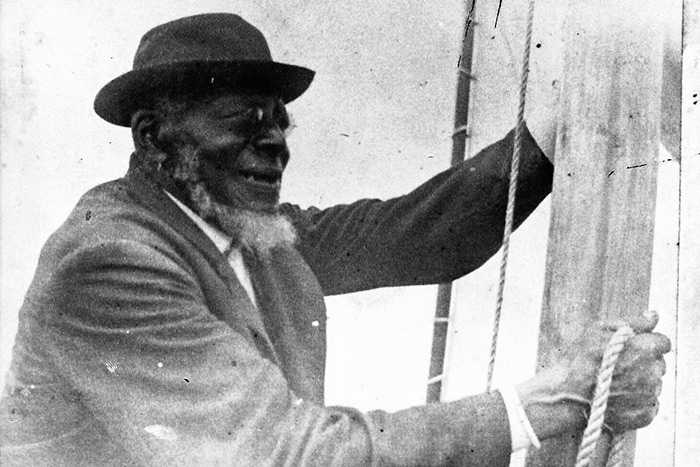Breaking Ground: Reconstruction of Pyrrhus Concer Home Is About to Begin

Sometime this fall, ground will be broken on what is going to be one of the most talked about homes in the Hamptons. It will not be the new summer White House home of the Clintons. It will not be the new home of Louis C.K. or Barack Obama. It will not be the next horse farm for Madonna.
Instead, it will be a very modest affair. It will be a humble little home just 30 feet across and 15 feet deep. It will be a reconstruction of a very old house (we have drawings). It will have no running water and no heat, other than a fireplace that some guy named Pyrrhus Concer once built when he moved into it when the original building was still standing, around 1850. It will be on one of the most valuable and most centrally located sites in Southampton—just under an acre, across Pond Lane from Lake Agawam, part way up a little hill. From the window of this home, way back in the 19th century, Pyrrhus Concer, a former slave, could look out at the lake in one direction, Monument Square in another, and Hill Street and Jobs Lane just a few steps away, where they come together. Most near to him was a landing on the lake where he kept a sailboat. He’d take summer people in bathing attire out in July and August, sailing across the pond to a landing on Meadow Lane near where the Southampton Bathing Association was later built. He charged a modest fee. They’d go to the beach and that’s how he made his money.
Concer’s home is to be re-constructed as it originally was, exactly where it originally was—by the Village of Southampton. It will be the centerpiece of a new activity celebrating the life of this remarkable man. You’ll be able to take a boat ride out into the lake. Also, you’ll be able to visit where he lived. This should all be happening by next summer.
Pyrrhus Concer was born in 1814 just as the War of 1812 between Britain and America was winding up. His mother and father were both slaves. They worked on a white man’s farm on the outskirts of Southampton. In 1827, slavery would be declared illegal in the State of New York, and eventually he would be freed. Slavery ran rampant in the south at that time, but it was also present in the north. There’s a record of Concer being sold from one farmer to another during that period.
When slavery in New York was finally abolished, Concer very likely didn’t know quite what to do with himself. At a certain point, he went out to see the world—signing up as a mate on one of the whaling ships that traveled the globe from its home port of bustling Sag Harbor. Concer was onboard an American whaling ship when it dropped anchor off Tokyo. Japan was closed off from the world at that time. It is believed that when he came ashore, he was likely the first African-American that any Japanese citizen had ever seen.
After many adventures, Concer left whaling—it ended when kerosene and gas began to be used for light and heat. Also, whales were hard to find. To get to them, hunters had to travel far and wide. In 1849, nearly all the Sag Harbor whaling ships at Long Wharf—more than a hundred of them—raced off to San Francisco to be part of the Gold Rush. Concer went to California, but soon after returned to Southampton and went into business for himself.
By that time, wealthy New York millionaires and their families were coming out to take summer vacations. In 1870, they were able to take the new Long Island Rail Road trains to summer homes they’d built here. Locally, they’d be met by servants at the station and taken off to their mansions. And for those living on the north side of Lake Agawam, it was far faster to get to the ocean beach if you took Concer’s little ferry across the lake rather than take a buggy ride with a horse pulling a cart on a dirt road all the way around.
Concer married Rachel Williams in 1847, lived a long life and died at the age of 83 in 1897. He’s mentioned in the local newspapers at that time. He was a kindly older man happy to talk to anyone on his ferry for 10 cents a trip. And he told stories, about his many travels. At the end of every day, he’d tie up his little boat at a dock at the north end of the lake and walk the few hundred feet through the park and up a hill to this little barn he’d made into his home. It had two rooms—a parlor as he might have called it, and a bedroom. There was an outhouse in the back. Warmth came from the fireplace he’d built. He could also cook food on the grating of that fireplace. He was buried in Southampton, and this is what is on his tombstone: “Though born a slave, he possessed those virtues, without which Kings are but slaves.”
After his death, his little home at 51 Pond Lane was sold to become home for future generations of families. Additions were built onto it. Water and electricity and a kitchen and indoor plumbing came along.
In 1979, the Village of Southampton authorized a historian to go around this historic community and identify all the historic places by putting them on a list. The Halsey House was put on it. The Pelletreau Silver Shop was put on it. Somehow, the home of this former slave was not put on it.
In 2013 a wealthy New York City couple who bought the property with this modest home on it for $2.75 million. That seems a small amount of money for a lot in today’s world, but it probably wasn’t because the historic house with its future uncertain was on it. This couple made a presentation to the Architectural Review Board in January of 2014 to tear down the home of Pyrrhus Concer so they could build a new home there. The presentation included a report made by historian Zachary Studenroth—that found the home didn’t exist on the list so it lacked the historical significance to be preserved. At 5,700 square feet, it would be on the small size of what we today call a McMansion. But with its other amenities—it would have a swimming pool and a pool house—
it would still be a formidable property indeed.
At that point, however, Mayor Mark Epley of Southampton Village was already putting forward the idea of saving the old slave home as a historic site, the Mayor told me. He also put into motion a program to honor Concer’s ferry rides. He’d get a little boat and offer rides around the pond to anyone who wanted one, with a historian on board to point out the sights. In addition, if he could get permission, this boat ride could provide another way to get to the beach from downtown. He’d have to arrange a landing site down on Meadow Lane for that to happen. But it could leave from Agawam Park.

Because this had been Concer’s house, the Village planning board rejected the proposal to build a big summer estate on that property. As a result, this couple filed a lawsuit. There was no earthly reason to restrict the use of their property like this, they said. There was no historic designation for this property.
Lacking any other option, the Mayor caved in. There was indeed nothing else that could be done. Embracing the idea that at least a couple would have a fine home, he allowed the permits to go thorough, so the couple was free to tear down Concer’s house. And they did, although they also permitted historians and village workers to take away parts of the home for preservation and perhaps later reconstruction somewhere else.
But then there was this shocker. After the demolition, the property, now free of any encumbrance that a home with historical significance might bring, the owners decided not to build and the property was put on the market for $4,995,000. Now this could be seen as a flip, where someone buys low, fixes the reason for the low price, and sells high.
In addition, since the owners had changed their minds about building, they requested the money they paid for the permits be refunded. The Village paid.
And, in the end, the Town of Southampton became the buyer of the property, with CPF (Community Preservation Fund) money, for $4.3 million—resulting in the couple’s walking off with nearly $2 million in profit from this little transaction.
It has taken two years to go from a pile of rubble to a plan to rebuild this historic house. In the interim, both this past summer and the summer before, a village employee put on a captain’s hat and became the captain of a 17-foot picnic boat with an electric motor, a small fringed awning and seating for eight. The picnic boat is called the Pyrrhus Concer, and on sunny days anyone who wants a ride can climb onboard—a little wooden dock and boardwalk has been built—and get a little 20-minute ride around Lake Agawam. It takes the same route that Concer took.
The house will be restored as it was when Concer lived in it. It will have modest furnishings inside. Artifacts from that 19th century will be displayed. Early this spring, a group of archeologists led a crew of volunteers onto the property and dug around. Some things they found were believed to be from the time that Concer lived there. They will be displayed, too.
Some $200,000 has been raised to fund this Village re-construction project. But as it happens, with today’s zoning, the location of the old house on the property really doesn’t meet current requirements. So the re-construction (by the village) is happily going through various variances (by the village) that can be offered to homes on sites that have grandfather status.
The house will be up, and the ferry rides will continue all next summer. Just come ashore and climb the little hill to the house’s front door. You’ll learn about Concer within.
And there’s a further expansion in the works. I spoke to Village Administrator Stephen Funsch about it. About $2 million will have to be raised. At the back of the property, there is a small barn that can be used next summer, with little restoration, as administration offices. Getting that intoshape will be “Phase 2.” After that comes “Phase 3.”
“The little barn in the back will be torn down for phase 3,” he told me. “In its place will be a new building that will have an exhibit hall of paraphernalia from that era of slavery, a classroom and conference room.” Chaleff & Rogers Architects are designing it. The administration will move back in. Also to be built will be an outdoor amphitheater. Shows, re-enactments and plays can be performed here.
“Because it’s on a hill, we will construct a zigzag walkway up to it, and it will be accompanied by a small brook with small waterfalls, ” Funsch told me. “This will be both the public and the disability access. You park on the street. Take the walk up. And if necessary, you can take the trip up in a little golf cart.”
Pyrrhus Concer would be astonished and, I think, proud to be remembered in this way. It is quite an achievement for our town, and everyone who takes pride in our history looks forward to it.



